University Sustainability Report: Weeks 1-7 Analysis and Findings
VerifiedAdded on 2021/06/17
|12
|3210
|58
Report
AI Summary
This report provides a comprehensive overview of sustainability, covering topics from global environmental challenges to sustainable business models. The student explores the increasing global population's impact on resource limitations and the evolution of environmentalism, including the Brundtland report's emphasis on economic development and environmental sustainability. The report delves into marketing and sustainability, highlighting consumer behavior and the importance of stakeholder engagement. It further examines sustainability accounting, organizational strategies, and the economics of sustainable development, including alternative indicators and business implications. Sustainable business models such as industrial ecology, natural capitalism, and carbon management are also discussed. The report provides examples of sustainable practices and organizational failures, offering insights into the complexities of achieving a sustainable future. Throughout the report, the student reflects on the acquired knowledge and the support received from colleagues.
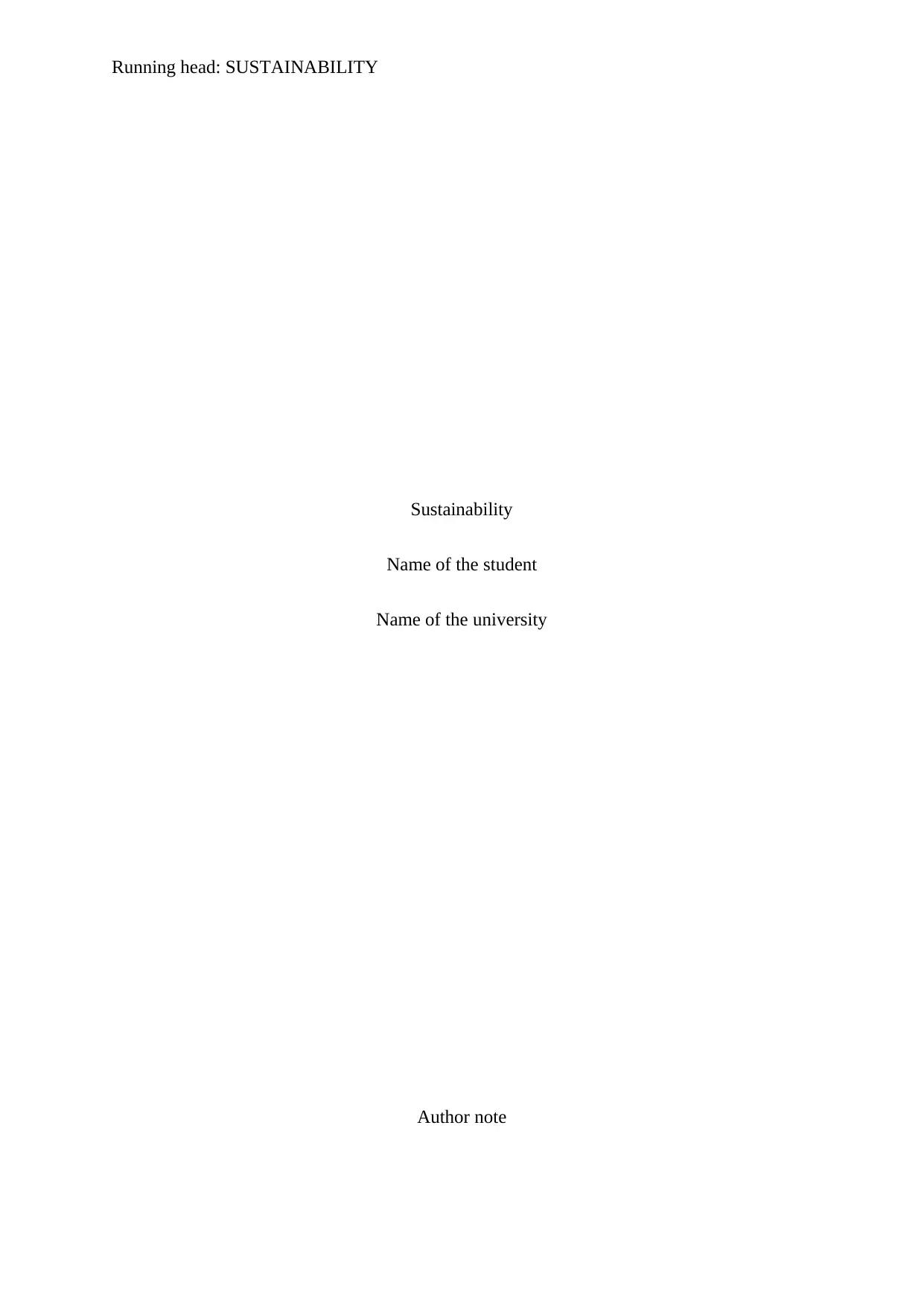
Running head: SUSTAINABILITY
Sustainability
Name of the student
Name of the university
Author note
Sustainability
Name of the student
Name of the university
Author note
Secure Best Marks with AI Grader
Need help grading? Try our AI Grader for instant feedback on your assignments.
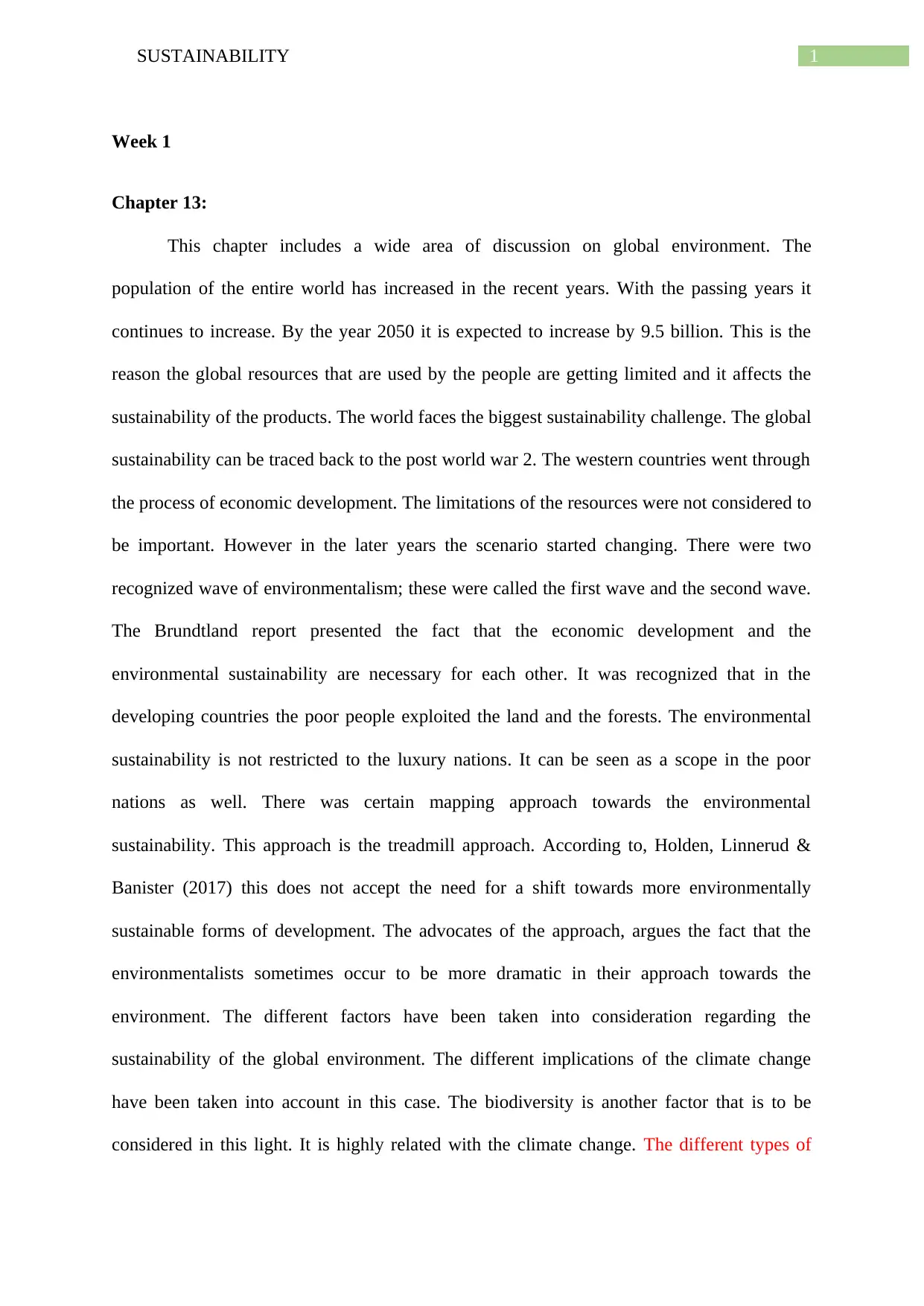
1SUSTAINABILITY
Week 1
Chapter 13:
This chapter includes a wide area of discussion on global environment. The
population of the entire world has increased in the recent years. With the passing years it
continues to increase. By the year 2050 it is expected to increase by 9.5 billion. This is the
reason the global resources that are used by the people are getting limited and it affects the
sustainability of the products. The world faces the biggest sustainability challenge. The global
sustainability can be traced back to the post world war 2. The western countries went through
the process of economic development. The limitations of the resources were not considered to
be important. However in the later years the scenario started changing. There were two
recognized wave of environmentalism; these were called the first wave and the second wave.
The Brundtland report presented the fact that the economic development and the
environmental sustainability are necessary for each other. It was recognized that in the
developing countries the poor people exploited the land and the forests. The environmental
sustainability is not restricted to the luxury nations. It can be seen as a scope in the poor
nations as well. There was certain mapping approach towards the environmental
sustainability. This approach is the treadmill approach. According to, Holden, Linnerud &
Banister (2017) this does not accept the need for a shift towards more environmentally
sustainable forms of development. The advocates of the approach, argues the fact that the
environmentalists sometimes occur to be more dramatic in their approach towards the
environment. The different factors have been taken into consideration regarding the
sustainability of the global environment. The different implications of the climate change
have been taken into account in this case. The biodiversity is another factor that is to be
considered in this light. It is highly related with the climate change. The different types of
Week 1
Chapter 13:
This chapter includes a wide area of discussion on global environment. The
population of the entire world has increased in the recent years. With the passing years it
continues to increase. By the year 2050 it is expected to increase by 9.5 billion. This is the
reason the global resources that are used by the people are getting limited and it affects the
sustainability of the products. The world faces the biggest sustainability challenge. The global
sustainability can be traced back to the post world war 2. The western countries went through
the process of economic development. The limitations of the resources were not considered to
be important. However in the later years the scenario started changing. There were two
recognized wave of environmentalism; these were called the first wave and the second wave.
The Brundtland report presented the fact that the economic development and the
environmental sustainability are necessary for each other. It was recognized that in the
developing countries the poor people exploited the land and the forests. The environmental
sustainability is not restricted to the luxury nations. It can be seen as a scope in the poor
nations as well. There was certain mapping approach towards the environmental
sustainability. This approach is the treadmill approach. According to, Holden, Linnerud &
Banister (2017) this does not accept the need for a shift towards more environmentally
sustainable forms of development. The advocates of the approach, argues the fact that the
environmentalists sometimes occur to be more dramatic in their approach towards the
environment. The different factors have been taken into consideration regarding the
sustainability of the global environment. The different implications of the climate change
have been taken into account in this case. The biodiversity is another factor that is to be
considered in this light. It is highly related with the climate change. The different types of
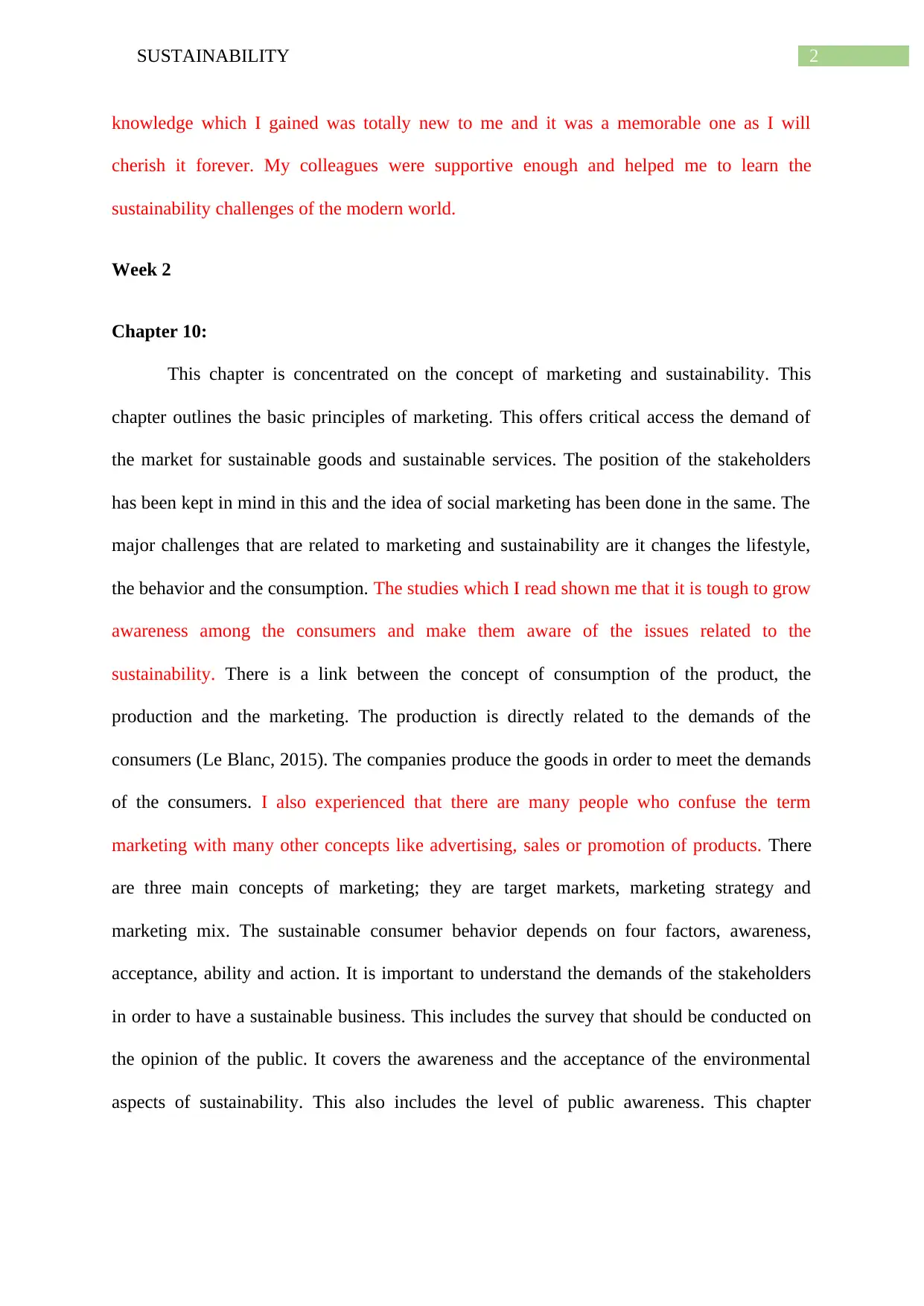
2SUSTAINABILITY
knowledge which I gained was totally new to me and it was a memorable one as I will
cherish it forever. My colleagues were supportive enough and helped me to learn the
sustainability challenges of the modern world.
Week 2
Chapter 10:
This chapter is concentrated on the concept of marketing and sustainability. This
chapter outlines the basic principles of marketing. This offers critical access the demand of
the market for sustainable goods and sustainable services. The position of the stakeholders
has been kept in mind in this and the idea of social marketing has been done in the same. The
major challenges that are related to marketing and sustainability are it changes the lifestyle,
the behavior and the consumption. The studies which I read shown me that it is tough to grow
awareness among the consumers and make them aware of the issues related to the
sustainability. There is a link between the concept of consumption of the product, the
production and the marketing. The production is directly related to the demands of the
consumers (Le Blanc, 2015). The companies produce the goods in order to meet the demands
of the consumers. I also experienced that there are many people who confuse the term
marketing with many other concepts like advertising, sales or promotion of products. There
are three main concepts of marketing; they are target markets, marketing strategy and
marketing mix. The sustainable consumer behavior depends on four factors, awareness,
acceptance, ability and action. It is important to understand the demands of the stakeholders
in order to have a sustainable business. This includes the survey that should be conducted on
the opinion of the public. It covers the awareness and the acceptance of the environmental
aspects of sustainability. This also includes the level of public awareness. This chapter
knowledge which I gained was totally new to me and it was a memorable one as I will
cherish it forever. My colleagues were supportive enough and helped me to learn the
sustainability challenges of the modern world.
Week 2
Chapter 10:
This chapter is concentrated on the concept of marketing and sustainability. This
chapter outlines the basic principles of marketing. This offers critical access the demand of
the market for sustainable goods and sustainable services. The position of the stakeholders
has been kept in mind in this and the idea of social marketing has been done in the same. The
major challenges that are related to marketing and sustainability are it changes the lifestyle,
the behavior and the consumption. The studies which I read shown me that it is tough to grow
awareness among the consumers and make them aware of the issues related to the
sustainability. There is a link between the concept of consumption of the product, the
production and the marketing. The production is directly related to the demands of the
consumers (Le Blanc, 2015). The companies produce the goods in order to meet the demands
of the consumers. I also experienced that there are many people who confuse the term
marketing with many other concepts like advertising, sales or promotion of products. There
are three main concepts of marketing; they are target markets, marketing strategy and
marketing mix. The sustainable consumer behavior depends on four factors, awareness,
acceptance, ability and action. It is important to understand the demands of the stakeholders
in order to have a sustainable business. This includes the survey that should be conducted on
the opinion of the public. It covers the awareness and the acceptance of the environmental
aspects of sustainability. This also includes the level of public awareness. This chapter
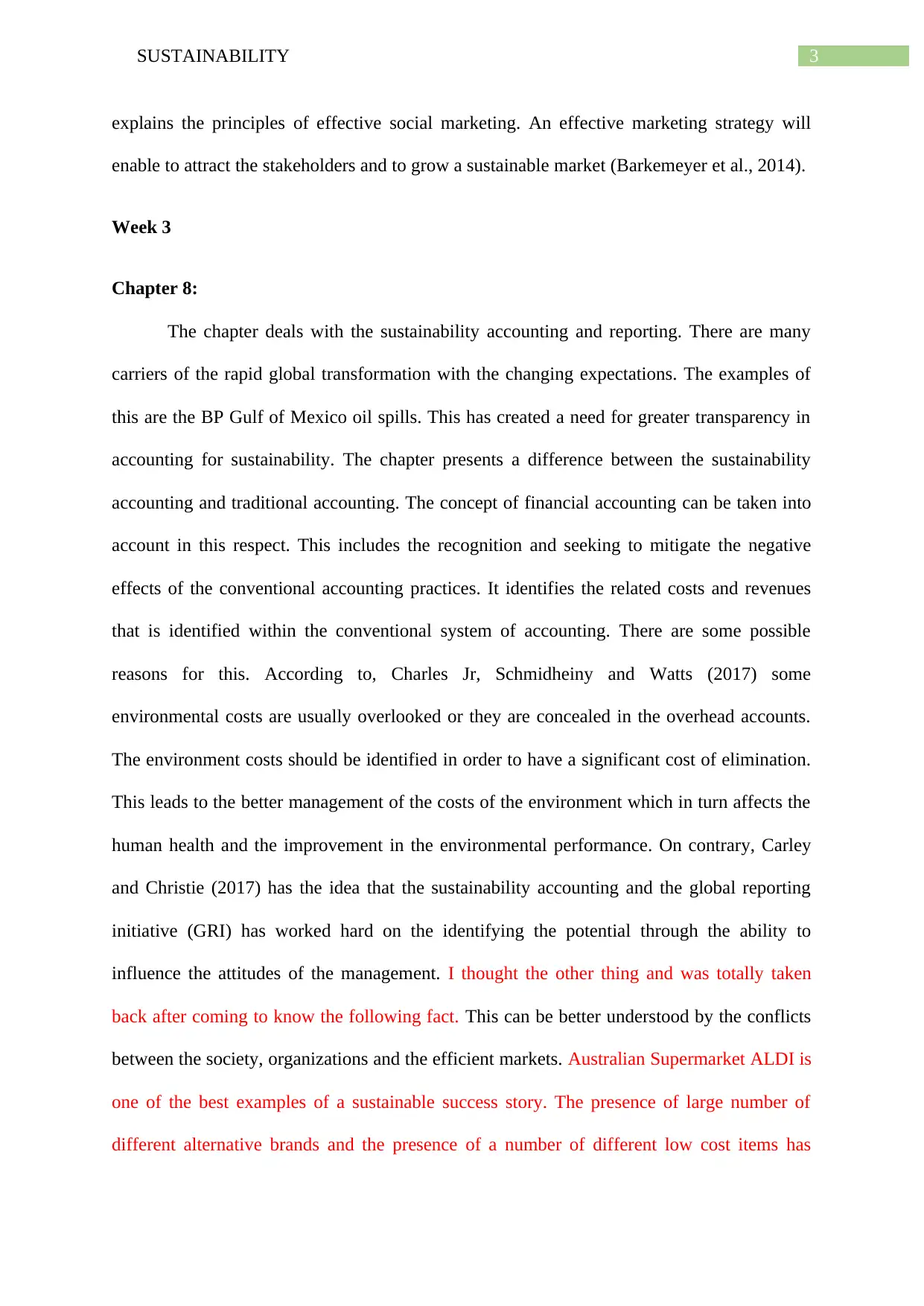
3SUSTAINABILITY
explains the principles of effective social marketing. An effective marketing strategy will
enable to attract the stakeholders and to grow a sustainable market (Barkemeyer et al., 2014).
Week 3
Chapter 8:
The chapter deals with the sustainability accounting and reporting. There are many
carriers of the rapid global transformation with the changing expectations. The examples of
this are the BP Gulf of Mexico oil spills. This has created a need for greater transparency in
accounting for sustainability. The chapter presents a difference between the sustainability
accounting and traditional accounting. The concept of financial accounting can be taken into
account in this respect. This includes the recognition and seeking to mitigate the negative
effects of the conventional accounting practices. It identifies the related costs and revenues
that is identified within the conventional system of accounting. There are some possible
reasons for this. According to, Charles Jr, Schmidheiny and Watts (2017) some
environmental costs are usually overlooked or they are concealed in the overhead accounts.
The environment costs should be identified in order to have a significant cost of elimination.
This leads to the better management of the costs of the environment which in turn affects the
human health and the improvement in the environmental performance. On contrary, Carley
and Christie (2017) has the idea that the sustainability accounting and the global reporting
initiative (GRI) has worked hard on the identifying the potential through the ability to
influence the attitudes of the management. I thought the other thing and was totally taken
back after coming to know the following fact. This can be better understood by the conflicts
between the society, organizations and the efficient markets. Australian Supermarket ALDI is
one of the best examples of a sustainable success story. The presence of large number of
different alternative brands and the presence of a number of different low cost items has
explains the principles of effective social marketing. An effective marketing strategy will
enable to attract the stakeholders and to grow a sustainable market (Barkemeyer et al., 2014).
Week 3
Chapter 8:
The chapter deals with the sustainability accounting and reporting. There are many
carriers of the rapid global transformation with the changing expectations. The examples of
this are the BP Gulf of Mexico oil spills. This has created a need for greater transparency in
accounting for sustainability. The chapter presents a difference between the sustainability
accounting and traditional accounting. The concept of financial accounting can be taken into
account in this respect. This includes the recognition and seeking to mitigate the negative
effects of the conventional accounting practices. It identifies the related costs and revenues
that is identified within the conventional system of accounting. There are some possible
reasons for this. According to, Charles Jr, Schmidheiny and Watts (2017) some
environmental costs are usually overlooked or they are concealed in the overhead accounts.
The environment costs should be identified in order to have a significant cost of elimination.
This leads to the better management of the costs of the environment which in turn affects the
human health and the improvement in the environmental performance. On contrary, Carley
and Christie (2017) has the idea that the sustainability accounting and the global reporting
initiative (GRI) has worked hard on the identifying the potential through the ability to
influence the attitudes of the management. I thought the other thing and was totally taken
back after coming to know the following fact. This can be better understood by the conflicts
between the society, organizations and the efficient markets. Australian Supermarket ALDI is
one of the best examples of a sustainable success story. The presence of large number of
different alternative brands and the presence of a number of different low cost items has
Secure Best Marks with AI Grader
Need help grading? Try our AI Grader for instant feedback on your assignments.
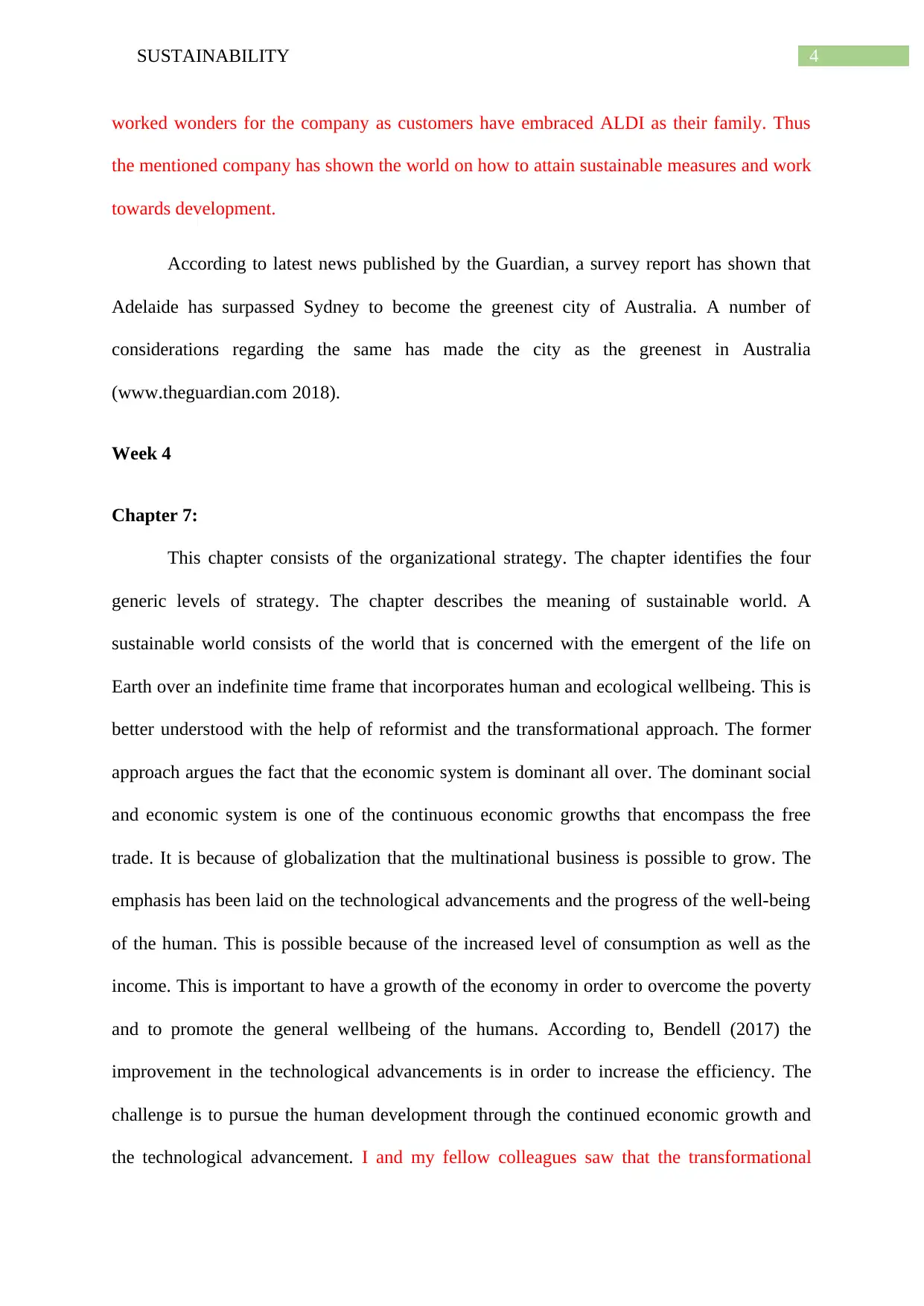
4SUSTAINABILITY
worked wonders for the company as customers have embraced ALDI as their family. Thus
the mentioned company has shown the world on how to attain sustainable measures and work
towards development.
According to latest news published by the Guardian, a survey report has shown that
Adelaide has surpassed Sydney to become the greenest city of Australia. A number of
considerations regarding the same has made the city as the greenest in Australia
(www.theguardian.com 2018).
Week 4
Chapter 7:
This chapter consists of the organizational strategy. The chapter identifies the four
generic levels of strategy. The chapter describes the meaning of sustainable world. A
sustainable world consists of the world that is concerned with the emergent of the life on
Earth over an indefinite time frame that incorporates human and ecological wellbeing. This is
better understood with the help of reformist and the transformational approach. The former
approach argues the fact that the economic system is dominant all over. The dominant social
and economic system is one of the continuous economic growths that encompass the free
trade. It is because of globalization that the multinational business is possible to grow. The
emphasis has been laid on the technological advancements and the progress of the well-being
of the human. This is possible because of the increased level of consumption as well as the
income. This is important to have a growth of the economy in order to overcome the poverty
and to promote the general wellbeing of the humans. According to, Bendell (2017) the
improvement in the technological advancements is in order to increase the efficiency. The
challenge is to pursue the human development through the continued economic growth and
the technological advancement. I and my fellow colleagues saw that the transformational
worked wonders for the company as customers have embraced ALDI as their family. Thus
the mentioned company has shown the world on how to attain sustainable measures and work
towards development.
According to latest news published by the Guardian, a survey report has shown that
Adelaide has surpassed Sydney to become the greenest city of Australia. A number of
considerations regarding the same has made the city as the greenest in Australia
(www.theguardian.com 2018).
Week 4
Chapter 7:
This chapter consists of the organizational strategy. The chapter identifies the four
generic levels of strategy. The chapter describes the meaning of sustainable world. A
sustainable world consists of the world that is concerned with the emergent of the life on
Earth over an indefinite time frame that incorporates human and ecological wellbeing. This is
better understood with the help of reformist and the transformational approach. The former
approach argues the fact that the economic system is dominant all over. The dominant social
and economic system is one of the continuous economic growths that encompass the free
trade. It is because of globalization that the multinational business is possible to grow. The
emphasis has been laid on the technological advancements and the progress of the well-being
of the human. This is possible because of the increased level of consumption as well as the
income. This is important to have a growth of the economy in order to overcome the poverty
and to promote the general wellbeing of the humans. According to, Bendell (2017) the
improvement in the technological advancements is in order to increase the efficiency. The
challenge is to pursue the human development through the continued economic growth and
the technological advancement. I and my fellow colleagues saw that the transformational
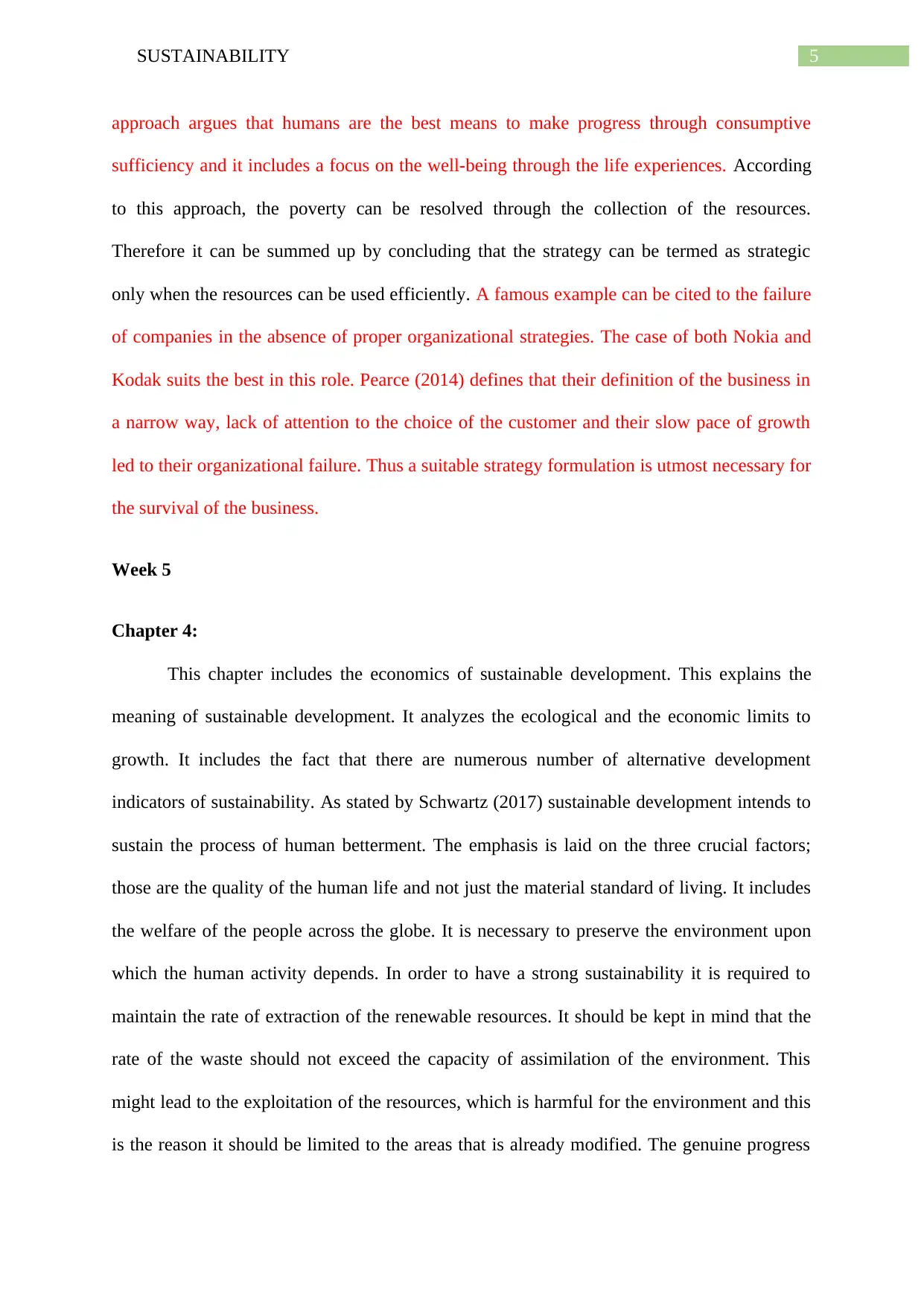
5SUSTAINABILITY
approach argues that humans are the best means to make progress through consumptive
sufficiency and it includes a focus on the well-being through the life experiences. According
to this approach, the poverty can be resolved through the collection of the resources.
Therefore it can be summed up by concluding that the strategy can be termed as strategic
only when the resources can be used efficiently. A famous example can be cited to the failure
of companies in the absence of proper organizational strategies. The case of both Nokia and
Kodak suits the best in this role. Pearce (2014) defines that their definition of the business in
a narrow way, lack of attention to the choice of the customer and their slow pace of growth
led to their organizational failure. Thus a suitable strategy formulation is utmost necessary for
the survival of the business.
Week 5
Chapter 4:
This chapter includes the economics of sustainable development. This explains the
meaning of sustainable development. It analyzes the ecological and the economic limits to
growth. It includes the fact that there are numerous number of alternative development
indicators of sustainability. As stated by Schwartz (2017) sustainable development intends to
sustain the process of human betterment. The emphasis is laid on the three crucial factors;
those are the quality of the human life and not just the material standard of living. It includes
the welfare of the people across the globe. It is necessary to preserve the environment upon
which the human activity depends. In order to have a strong sustainability it is required to
maintain the rate of extraction of the renewable resources. It should be kept in mind that the
rate of the waste should not exceed the capacity of assimilation of the environment. This
might lead to the exploitation of the resources, which is harmful for the environment and this
is the reason it should be limited to the areas that is already modified. The genuine progress
approach argues that humans are the best means to make progress through consumptive
sufficiency and it includes a focus on the well-being through the life experiences. According
to this approach, the poverty can be resolved through the collection of the resources.
Therefore it can be summed up by concluding that the strategy can be termed as strategic
only when the resources can be used efficiently. A famous example can be cited to the failure
of companies in the absence of proper organizational strategies. The case of both Nokia and
Kodak suits the best in this role. Pearce (2014) defines that their definition of the business in
a narrow way, lack of attention to the choice of the customer and their slow pace of growth
led to their organizational failure. Thus a suitable strategy formulation is utmost necessary for
the survival of the business.
Week 5
Chapter 4:
This chapter includes the economics of sustainable development. This explains the
meaning of sustainable development. It analyzes the ecological and the economic limits to
growth. It includes the fact that there are numerous number of alternative development
indicators of sustainability. As stated by Schwartz (2017) sustainable development intends to
sustain the process of human betterment. The emphasis is laid on the three crucial factors;
those are the quality of the human life and not just the material standard of living. It includes
the welfare of the people across the globe. It is necessary to preserve the environment upon
which the human activity depends. In order to have a strong sustainability it is required to
maintain the rate of extraction of the renewable resources. It should be kept in mind that the
rate of the waste should not exceed the capacity of assimilation of the environment. This
might lead to the exploitation of the resources, which is harmful for the environment and this
is the reason it should be limited to the areas that is already modified. The genuine progress
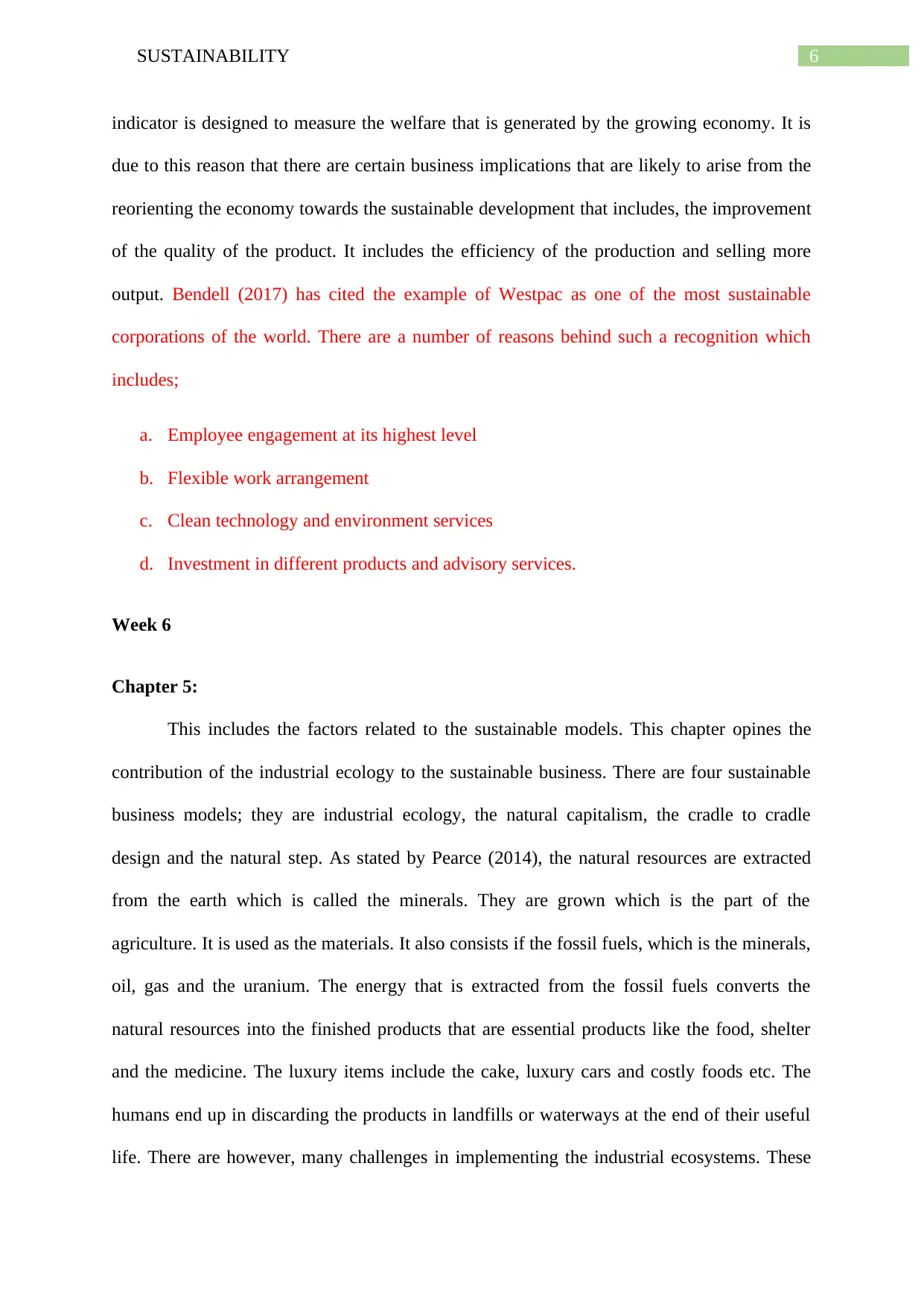
6SUSTAINABILITY
indicator is designed to measure the welfare that is generated by the growing economy. It is
due to this reason that there are certain business implications that are likely to arise from the
reorienting the economy towards the sustainable development that includes, the improvement
of the quality of the product. It includes the efficiency of the production and selling more
output. Bendell (2017) has cited the example of Westpac as one of the most sustainable
corporations of the world. There are a number of reasons behind such a recognition which
includes;
a. Employee engagement at its highest level
b. Flexible work arrangement
c. Clean technology and environment services
d. Investment in different products and advisory services.
Week 6
Chapter 5:
This includes the factors related to the sustainable models. This chapter opines the
contribution of the industrial ecology to the sustainable business. There are four sustainable
business models; they are industrial ecology, the natural capitalism, the cradle to cradle
design and the natural step. As stated by Pearce (2014), the natural resources are extracted
from the earth which is called the minerals. They are grown which is the part of the
agriculture. It is used as the materials. It also consists if the fossil fuels, which is the minerals,
oil, gas and the uranium. The energy that is extracted from the fossil fuels converts the
natural resources into the finished products that are essential products like the food, shelter
and the medicine. The luxury items include the cake, luxury cars and costly foods etc. The
humans end up in discarding the products in landfills or waterways at the end of their useful
life. There are however, many challenges in implementing the industrial ecosystems. These
indicator is designed to measure the welfare that is generated by the growing economy. It is
due to this reason that there are certain business implications that are likely to arise from the
reorienting the economy towards the sustainable development that includes, the improvement
of the quality of the product. It includes the efficiency of the production and selling more
output. Bendell (2017) has cited the example of Westpac as one of the most sustainable
corporations of the world. There are a number of reasons behind such a recognition which
includes;
a. Employee engagement at its highest level
b. Flexible work arrangement
c. Clean technology and environment services
d. Investment in different products and advisory services.
Week 6
Chapter 5:
This includes the factors related to the sustainable models. This chapter opines the
contribution of the industrial ecology to the sustainable business. There are four sustainable
business models; they are industrial ecology, the natural capitalism, the cradle to cradle
design and the natural step. As stated by Pearce (2014), the natural resources are extracted
from the earth which is called the minerals. They are grown which is the part of the
agriculture. It is used as the materials. It also consists if the fossil fuels, which is the minerals,
oil, gas and the uranium. The energy that is extracted from the fossil fuels converts the
natural resources into the finished products that are essential products like the food, shelter
and the medicine. The luxury items include the cake, luxury cars and costly foods etc. The
humans end up in discarding the products in landfills or waterways at the end of their useful
life. There are however, many challenges in implementing the industrial ecosystems. These
Paraphrase This Document
Need a fresh take? Get an instant paraphrase of this document with our AI Paraphraser
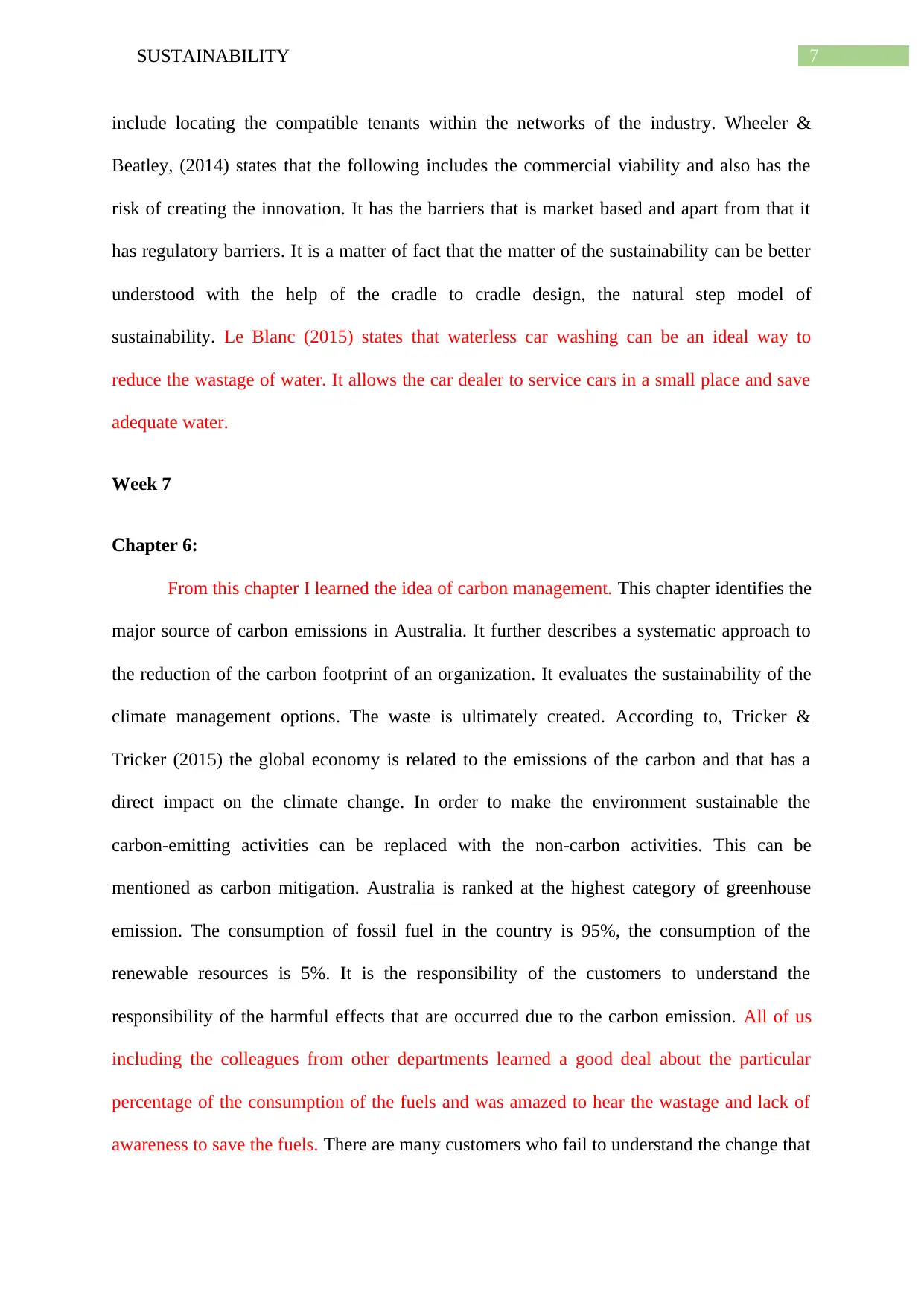
7SUSTAINABILITY
include locating the compatible tenants within the networks of the industry. Wheeler &
Beatley, (2014) states that the following includes the commercial viability and also has the
risk of creating the innovation. It has the barriers that is market based and apart from that it
has regulatory barriers. It is a matter of fact that the matter of the sustainability can be better
understood with the help of the cradle to cradle design, the natural step model of
sustainability. Le Blanc (2015) states that waterless car washing can be an ideal way to
reduce the wastage of water. It allows the car dealer to service cars in a small place and save
adequate water.
Week 7
Chapter 6:
From this chapter I learned the idea of carbon management. This chapter identifies the
major source of carbon emissions in Australia. It further describes a systematic approach to
the reduction of the carbon footprint of an organization. It evaluates the sustainability of the
climate management options. The waste is ultimately created. According to, Tricker &
Tricker (2015) the global economy is related to the emissions of the carbon and that has a
direct impact on the climate change. In order to make the environment sustainable the
carbon-emitting activities can be replaced with the non-carbon activities. This can be
mentioned as carbon mitigation. Australia is ranked at the highest category of greenhouse
emission. The consumption of fossil fuel in the country is 95%, the consumption of the
renewable resources is 5%. It is the responsibility of the customers to understand the
responsibility of the harmful effects that are occurred due to the carbon emission. All of us
including the colleagues from other departments learned a good deal about the particular
percentage of the consumption of the fuels and was amazed to hear the wastage and lack of
awareness to save the fuels. There are many customers who fail to understand the change that
include locating the compatible tenants within the networks of the industry. Wheeler &
Beatley, (2014) states that the following includes the commercial viability and also has the
risk of creating the innovation. It has the barriers that is market based and apart from that it
has regulatory barriers. It is a matter of fact that the matter of the sustainability can be better
understood with the help of the cradle to cradle design, the natural step model of
sustainability. Le Blanc (2015) states that waterless car washing can be an ideal way to
reduce the wastage of water. It allows the car dealer to service cars in a small place and save
adequate water.
Week 7
Chapter 6:
From this chapter I learned the idea of carbon management. This chapter identifies the
major source of carbon emissions in Australia. It further describes a systematic approach to
the reduction of the carbon footprint of an organization. It evaluates the sustainability of the
climate management options. The waste is ultimately created. According to, Tricker &
Tricker (2015) the global economy is related to the emissions of the carbon and that has a
direct impact on the climate change. In order to make the environment sustainable the
carbon-emitting activities can be replaced with the non-carbon activities. This can be
mentioned as carbon mitigation. Australia is ranked at the highest category of greenhouse
emission. The consumption of fossil fuel in the country is 95%, the consumption of the
renewable resources is 5%. It is the responsibility of the customers to understand the
responsibility of the harmful effects that are occurred due to the carbon emission. All of us
including the colleagues from other departments learned a good deal about the particular
percentage of the consumption of the fuels and was amazed to hear the wastage and lack of
awareness to save the fuels. There are many customers who fail to understand the change that

8SUSTAINABILITY
occurs in the climate. They do not understand the influence of the same on the business
production systems. The effective way to eradicate this is to analyze the carbon footprint
model, the climate risk and the opportunities related to the same can be analyzed. The
humans should shift their focus on the use of the renewable sources of energy. However the
emission of carbon can be reduced by following a systematic approach. On the other hand
Schwartz (2017) the systematic approach can be followed to reduce the carbon footprint of
the organization. An effective evaluation of the sustainability of climate management should
be made. The use of sodium batteries in cars in place of Lithium batteries is another example
of sustainable development. The European Union has already formulated plans to build a
battery making consortium to compete with the lithium ion market leaders of the business.
The new sustainable change will help in developing a green world. The following has been
highlighted in the class.
Week 8
Chapter 3:
The chapter concentrates on the business ethics, corporate governance and the
corporate social responsibility. The chapter discusses the key features of an ethical business.
It identifies the principle of good governance and different elements of the corporate social
responsibility. Business ethics is the application of the general ethical ideas to the behavior of
business. According to, Carroll (2015) under this context this can be identified that society
should maintain the responsibility to save the environment. It will upgrade the reputation of
the people. Better ethics leads to better reputation which in turn leads to competitive
advantage and profit. The principles of good governance is transparency, rule of law,
participation, responsibility, equity and fairness, this further include the efficiency and
effectiveness, sustainability and accountability. On the other hand, Tai & Chuang, (2014)
occurs in the climate. They do not understand the influence of the same on the business
production systems. The effective way to eradicate this is to analyze the carbon footprint
model, the climate risk and the opportunities related to the same can be analyzed. The
humans should shift their focus on the use of the renewable sources of energy. However the
emission of carbon can be reduced by following a systematic approach. On the other hand
Schwartz (2017) the systematic approach can be followed to reduce the carbon footprint of
the organization. An effective evaluation of the sustainability of climate management should
be made. The use of sodium batteries in cars in place of Lithium batteries is another example
of sustainable development. The European Union has already formulated plans to build a
battery making consortium to compete with the lithium ion market leaders of the business.
The new sustainable change will help in developing a green world. The following has been
highlighted in the class.
Week 8
Chapter 3:
The chapter concentrates on the business ethics, corporate governance and the
corporate social responsibility. The chapter discusses the key features of an ethical business.
It identifies the principle of good governance and different elements of the corporate social
responsibility. Business ethics is the application of the general ethical ideas to the behavior of
business. According to, Carroll (2015) under this context this can be identified that society
should maintain the responsibility to save the environment. It will upgrade the reputation of
the people. Better ethics leads to better reputation which in turn leads to competitive
advantage and profit. The principles of good governance is transparency, rule of law,
participation, responsibility, equity and fairness, this further include the efficiency and
effectiveness, sustainability and accountability. On the other hand, Tai & Chuang, (2014)
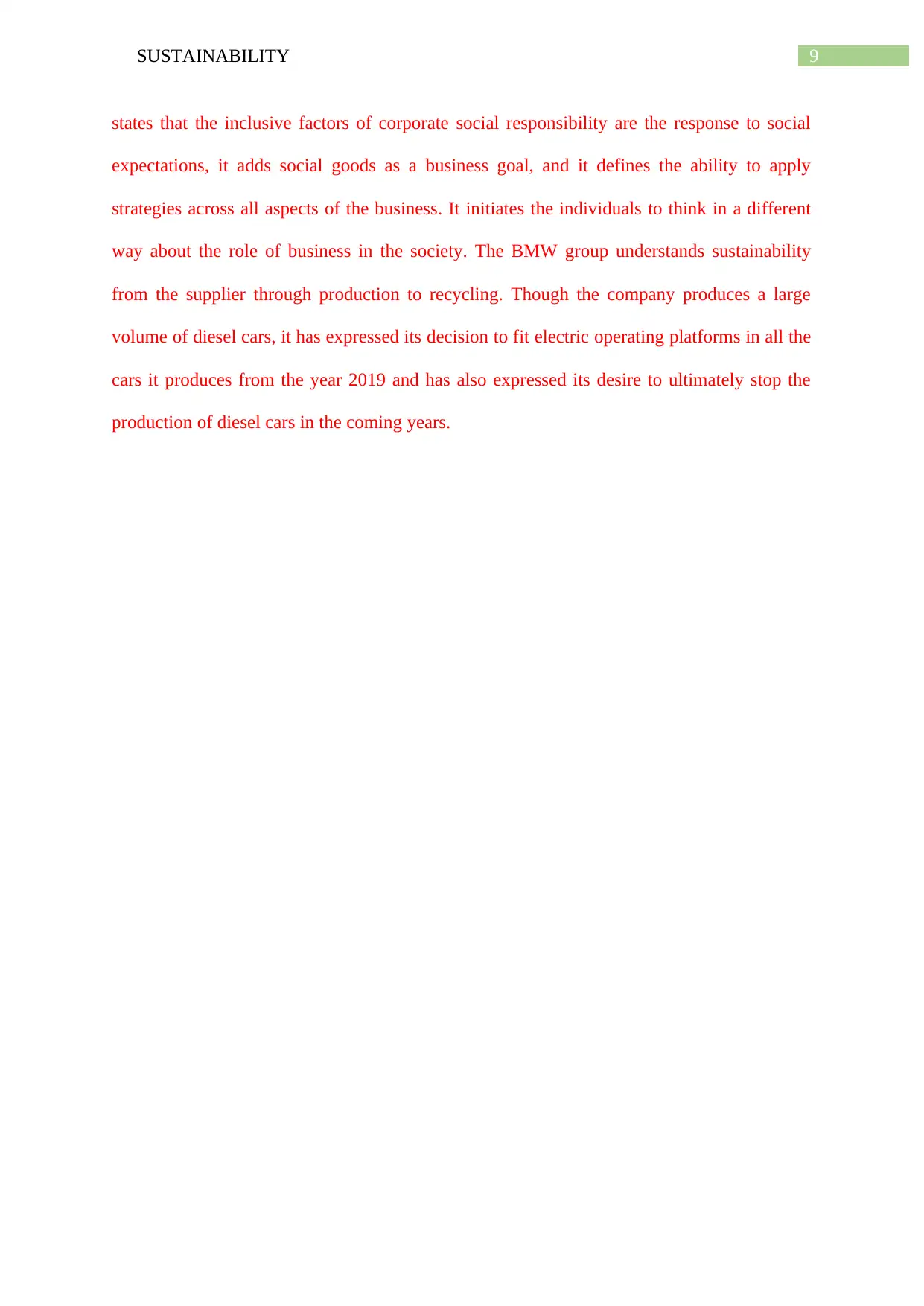
9SUSTAINABILITY
states that the inclusive factors of corporate social responsibility are the response to social
expectations, it adds social goods as a business goal, and it defines the ability to apply
strategies across all aspects of the business. It initiates the individuals to think in a different
way about the role of business in the society. The BMW group understands sustainability
from the supplier through production to recycling. Though the company produces a large
volume of diesel cars, it has expressed its decision to fit electric operating platforms in all the
cars it produces from the year 2019 and has also expressed its desire to ultimately stop the
production of diesel cars in the coming years.
states that the inclusive factors of corporate social responsibility are the response to social
expectations, it adds social goods as a business goal, and it defines the ability to apply
strategies across all aspects of the business. It initiates the individuals to think in a different
way about the role of business in the society. The BMW group understands sustainability
from the supplier through production to recycling. Though the company produces a large
volume of diesel cars, it has expressed its decision to fit electric operating platforms in all the
cars it produces from the year 2019 and has also expressed its desire to ultimately stop the
production of diesel cars in the coming years.
Secure Best Marks with AI Grader
Need help grading? Try our AI Grader for instant feedback on your assignments.

10SUSTAINABILITY
References
Barkemeyer, R., Holt, D., Preuss, L., & Tsang, S. (2014). What happened to the
‘development’in sustainable development? Business guidelines two decades after
Brundtland. sustainable development, 22(1), 15-32.
Bendell, J. (2017). Terms for endearment: Business, NGOs and sustainable development.
Routledge.
Carley, M., & Christie, I. (2017). Managing sustainable development. Routledge.
Carroll, A. B. (2015). Corporate social responsibility. Organizational dynamics, 44(2), 87-96.
Charles Jr, O. H., Schmidheiny, S., & Watts, P. (2017). Walking the talk: The business case
for sustainable development. Routledge.
Dodd, E. M. (2017). For whom are corporate managers trustees?. In Corporate Governance
(pp. 29-47). Gower.
Holden, E., Linnerud, K., & Banister, D. (2017). The imperatives of sustainable development.
Sustainable Development, 25(3), 213-226.
Kane, A. (2018). Australia's greenest city: Adelaide pulls ahead of Sydney and Melbourne.
[online] the Guardian. Available at: https://www.theguardian.com/sustainable-
business/2016/feb/12/australias-greenest-city-adelaide-pulls-ahead-of-sydney-and-
melbourne [Accessed 21 May 2018].
Le Blanc, D. (2015). Towards integration at last? The sustainable development goals as a
network of targets. Sustainable Development, 23(3), 176-187.
Pearce, D. (2014). Blueprint 3: Measuring sustainable development. Routledge.
Schwartz, M. S. (2017). Corporate social responsibility. Routledge.
References
Barkemeyer, R., Holt, D., Preuss, L., & Tsang, S. (2014). What happened to the
‘development’in sustainable development? Business guidelines two decades after
Brundtland. sustainable development, 22(1), 15-32.
Bendell, J. (2017). Terms for endearment: Business, NGOs and sustainable development.
Routledge.
Carley, M., & Christie, I. (2017). Managing sustainable development. Routledge.
Carroll, A. B. (2015). Corporate social responsibility. Organizational dynamics, 44(2), 87-96.
Charles Jr, O. H., Schmidheiny, S., & Watts, P. (2017). Walking the talk: The business case
for sustainable development. Routledge.
Dodd, E. M. (2017). For whom are corporate managers trustees?. In Corporate Governance
(pp. 29-47). Gower.
Holden, E., Linnerud, K., & Banister, D. (2017). The imperatives of sustainable development.
Sustainable Development, 25(3), 213-226.
Kane, A. (2018). Australia's greenest city: Adelaide pulls ahead of Sydney and Melbourne.
[online] the Guardian. Available at: https://www.theguardian.com/sustainable-
business/2016/feb/12/australias-greenest-city-adelaide-pulls-ahead-of-sydney-and-
melbourne [Accessed 21 May 2018].
Le Blanc, D. (2015). Towards integration at last? The sustainable development goals as a
network of targets. Sustainable Development, 23(3), 176-187.
Pearce, D. (2014). Blueprint 3: Measuring sustainable development. Routledge.
Schwartz, M. S. (2017). Corporate social responsibility. Routledge.
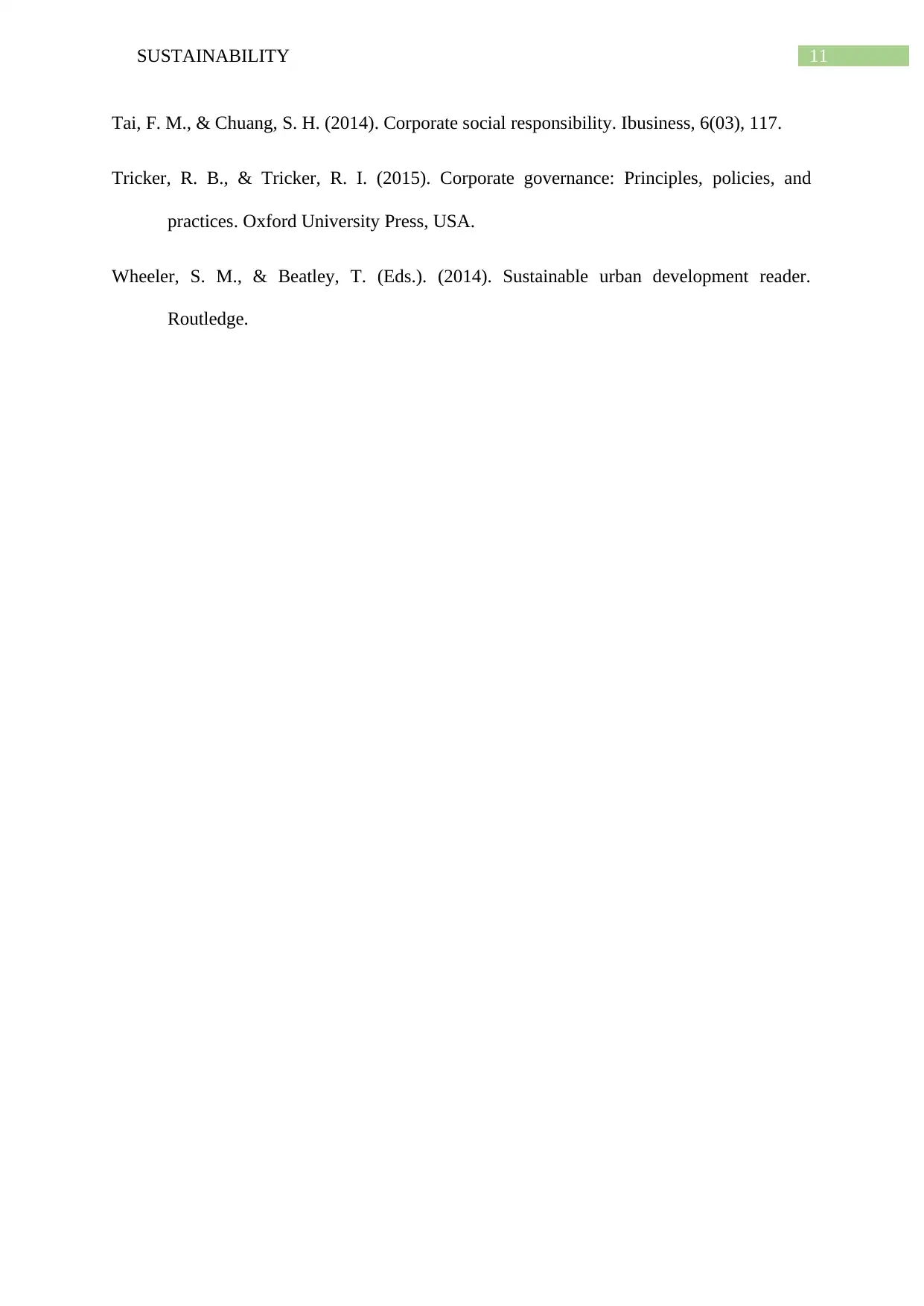
11SUSTAINABILITY
Tai, F. M., & Chuang, S. H. (2014). Corporate social responsibility. Ibusiness, 6(03), 117.
Tricker, R. B., & Tricker, R. I. (2015). Corporate governance: Principles, policies, and
practices. Oxford University Press, USA.
Wheeler, S. M., & Beatley, T. (Eds.). (2014). Sustainable urban development reader.
Routledge.
Tai, F. M., & Chuang, S. H. (2014). Corporate social responsibility. Ibusiness, 6(03), 117.
Tricker, R. B., & Tricker, R. I. (2015). Corporate governance: Principles, policies, and
practices. Oxford University Press, USA.
Wheeler, S. M., & Beatley, T. (Eds.). (2014). Sustainable urban development reader.
Routledge.
1 out of 12
Related Documents
Your All-in-One AI-Powered Toolkit for Academic Success.
+13062052269
info@desklib.com
Available 24*7 on WhatsApp / Email
![[object Object]](/_next/static/media/star-bottom.7253800d.svg)
Unlock your academic potential
© 2024 | Zucol Services PVT LTD | All rights reserved.





